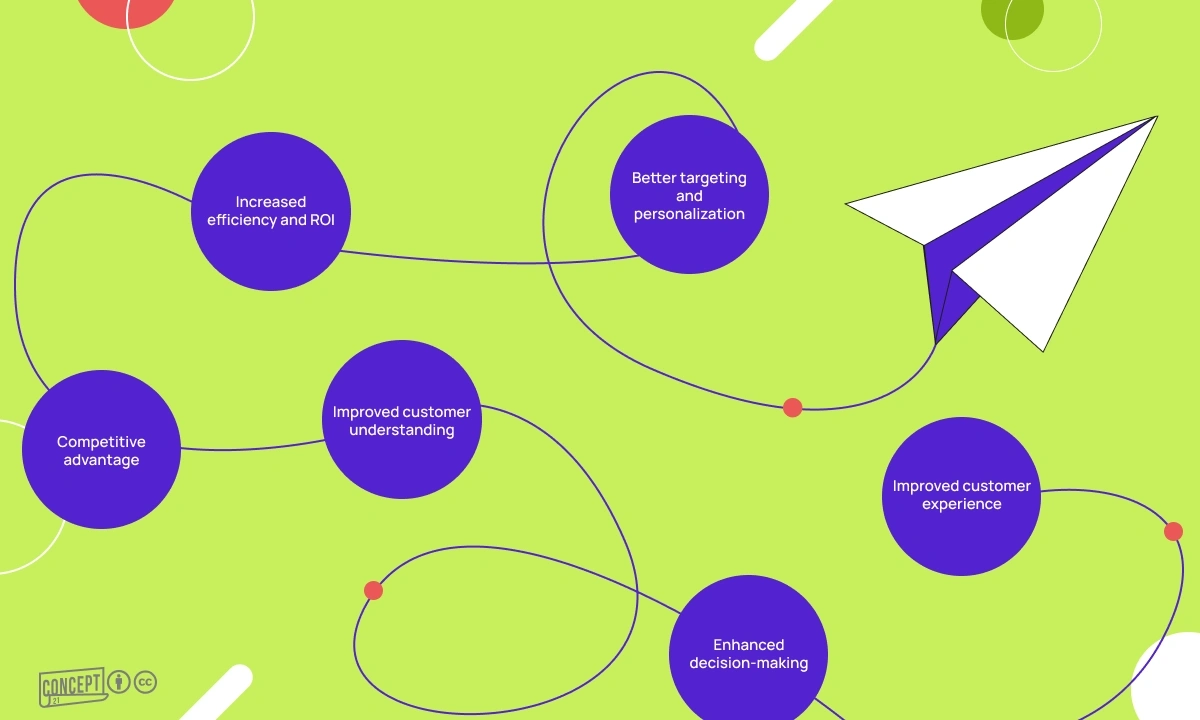Back to all Articles
Data-Driven Marketing: How to Start, Succeed, and Boost ROI

Are you tired of guessing and hoping your marketing campaigns will be successful? It's time to ditch the guesswork and embrace the power of data-driven marketing. Using data to inform your marketing decisions, you can create more targeted, effective campaigns that drive actual results.
This article will dive into data-driven marketing and show you how to use data to take your marketing to the next level. So let's start using data to drive our marketing decisions and dominate the competition!
This article will dive into data-driven marketing and show you how to use data to take your marketing to the next level. So let's start using data to drive our marketing decisions and dominate the competition!
What is data-driven marketing?
Data-driven marketing is the practice of using data to guide every marketing decision, from campaign planning to performance evaluation. By analyzing customer demographics, online behavior, website analytics, and social media engagement, businesses gain actionable insights into what works and what doesn’t.
In today’s AI-powered marketing landscape, platforms like ChatGPT, Gemini, and other AI analytics tools can process massive datasets, helping marketers identify trends, predict customer behavior, and optimize campaigns in real time. This not only improves efficiency but also enhances personalization, allowing you to deliver the right message to the right audience at the right time.
In today’s AI-powered marketing landscape, platforms like ChatGPT, Gemini, and other AI analytics tools can process massive datasets, helping marketers identify trends, predict customer behavior, and optimize campaigns in real time. This not only improves efficiency but also enhances personalization, allowing you to deliver the right message to the right audience at the right time.
Benefits of data-driven marketing

Adopting a data-driven marketing approach offers numerous advantages for businesses looking to stay competitive in the digital era. By leveraging AI analytics tools, real-time insights, and customer data, you can create campaigns that truly resonate with your audience. Here are the key benefits:
1. Increased efficiency and ROI
Using AI-powered analytics to optimize marketing campaigns saves time and resources while boosting return on investment (ROI). Concept21 helps businesses implement strategies that convert data into measurable results.
2. Better targeting and personalization
Data allows you to segment your audience and create personalized marketing campaigns that speak directly to their needs and interests.
3. Improved customer understanding
AI tools and analytics platforms provide deep insights into your customers’ habits, motivations, and needs. This enables businesses to make informed decisions and design campaigns that align perfectly with audience expectations.
4. Enhanced decision-making
Data provides a solid foundation for making informed decisions about your marketing strategies rather than relying on gut feelings or assumptions.
5. Competitive advantage
By leveraging data-driven insights and AI analytics, businesses can monitor industry trends and consumer behavior in real time, staying one step ahead of the competition in any region.
6. Improved customer experience
Personalized campaigns powered by data analytics create a better customer journey, building loyalty and long-term relationships. Concept21 specializes in turning these insights into actionable marketing strategies that enhance the overall customer experience.
Thought-provoking data-driven marketing statistics
- Almost 7 in 10 leading marketers say that their companies use data in decision-making at all levels.
- According to 75% of marketers, the most significant barrier to making more and better business decisions is a lack of education and training in using data.
- Customer experience and journey mapping are one the most popular area (48%) where data-driven marketing is used. This is followed by email marketing (42%) and personalization (41%).
- 1 in 3 marketers says that data-driven decisions are more effective than “gut instinct”.
- Customers (80%) prefer to buy from brands that offer tailored experiences.
- 38% of customers say they will again use a brand with which they had a good experience, even if there are cheaper or more convenient options.
- According to 62% of customers, the brand will lose their loyalty if they offers an unpersonalized experience.
- 6 out of 10 responders planned to increase investments in personalization in 2022.
- Over 40% of businesses the brand will lose their loyalty if they offers an unpersonalized experience.
- Behaviorally targeted ads have a 5.3 times higher click-through rate than ads that don’t use behavioral data.
How to start data-driven marketing?
1. Gathering the correct data

The first step in data-driven marketing is identifying the data that will most impact your marketing goals. Valuable data sources include:
- Customer demographics: Age, location, interests, and purchasing behavior
- Website analytics: Traffic, user behavior, and conversion rates
- Social media metrics: Engagement, follower growth, and content performance
- Other sources: Email campaigns, CRM systems, and customer feedback
To determine the data you need, start by defining your marketing objectives. For instance:
- If your goal is to increase website traffic, focus on visitor behavior and page analytics.
- If your goal is to improve customer retention, analyze purchasing patterns and engagement trends.
2. Use the right tools to collect data

Once you know what data you need, leverage tools that make data collection and analysis simple:
With these tools, you can gather accurate, actionable data that informs your marketing strategies and boosts campaign performance.
- Google Analytics 4: Free website analytics for tracking traffic, user behavior, and conversions
- A/B Testing Tools: Platforms like Optimizely or VWO to test and optimize campaigns
- CRM Software: Tools like Salesforce or HubSpot for managing and analyzing customer data in one place
- Social Media Analytics Tools: Hootsuite or Sprout Social to track engagement and follower growth
With these tools, you can gather accurate, actionable data that informs your marketing strategies and boosts campaign performance.
💡 Don’t limit yourself to standard analytics platforms. Consider alternative sources like customer surveys, online reviews, or even AI-powered insights from tools like ChatGPT and Gemini, which can help analyze trends and customer sentiment.
3. Using data to inform marketing decisions
Curious about how to leverage data to improve targeting, messaging, and campaign planning? While it might seem intimidating at first, the process is straightforward when approached systematically.
For example:
For example:
- Facebook Ads: By analyzing your audience’s demographics, interests, and behaviors, you can create highly targeted ads that speak directly to their needs.
- Email Marketing: Tracking engagement metrics, such as open rates and click-through rates, allows you to optimize subject lines and messaging, increasing the chances that subscribers take action.
💡 The key is to use data to inform your marketing decisions rather than relying on assumptions or gut feelings.
Accurate data is the foundation for effective segmentation and personalization. By dividing your audience into smaller groups based on shared characteristics and behaviors, you can deliver marketing campaigns that resonate deeply. This approach not only increases campaign effectiveness but also enhances the customer experience and strengthens long-term relationships.
4. Implementing data-driven marketing strategies

4.1. Define goals and objectives
Clear goals are essential for guiding your data-driven marketing efforts and measuring success. Whether your aim is to:
…ensure your objectives follow the SMART framework (Specific, Measurable, Achievable, Relevant, Time-bound). By tracking progress with data, you can adjust strategies in real time to achieve the desired results.
- Increase website traffic
- Boost conversions
- Build brand awareness
…ensure your objectives follow the SMART framework (Specific, Measurable, Achievable, Relevant, Time-bound). By tracking progress with data, you can adjust strategies in real time to achieve the desired results.
4.2. Develop a plan and budget
A data-driven marketing plan and budget ensures that your campaigns are effective and deliver maximum ROI. Allocate resources for:
Regularly review your plan and budget to stay ahead of the competition and make the most of your data.
- Data collection
- Analysis
- Strategy implementation
Regularly review your plan and budget to stay ahead of the competition and make the most of your data.
💡 Don't skimp on this budget - investing in data-driven marketing will pay off in the long run.
4.3. Measure and optimize results
After implementing your strategies, the next step is continuous measurement and analysis. Data-driven marketing shines in this phase, enabling you to:
- Track progress against your goals
- Identify what’s working and what needs adjustment
- Optimize targeting, messaging, and campaign structure
- Launch new campaigns with confidence
💡 Don't just gather data and forget about it - use it to drive your marketing decisions and optimize your strategies for maximum success.
Mind-blowing data-driven marketing examples
Here’s how some of the big names use data-driven marketing…
- Netflix suggests personalized movie and TV show recommendations to users based on their viewing history.
- Amazon personalizes product recommendations for each customer based on their browsing and purchasing history.
- Airbnb matches travelers with the most suitable vacation rentals based on their preferences and past bookings.
- Spotify creates personalized playlists for each user based on their listening history and preferences.
- Google personalizes search results for each user based on their location, search history, and other factors.
Unlock your marketing potential with Concept21
Implementing data-driven marketing can be challenging without the right tools, expertise, and guidance. That’s where Concept21 comes in. We help businesses of all sizes harness the power of AI-powered analytics, real-time data insights, and targeted marketing strategies to maximize ROI and drive growth.
With Concept21, you can:
Ready to elevate your marketing? Let Concept21 help you transform data into results. Contact us today to start your journey toward smarter, more effective marketing.
With Concept21, you can:
- Turn raw data into actionable strategies that improve campaign performance
- Leverage AI and advanced analytics to predict customer behavior and optimize targeting
- Enhance customer experience with highly personalized, data-driven campaigns
- Stay ahead of the competition by monitoring trends and adjusting strategies in real time
Ready to elevate your marketing? Let Concept21 help you transform data into results. Contact us today to start your journey toward smarter, more effective marketing.
F.A.Q
What is data-driven marketing?
Data-driven marketing is a marketing strategy informed by data and analytics better to understand customer behavior, preferences, and trends. It uses data to make decisions and optimize marketing campaigns to maximize ROI. Data-driven marketing focuses on understanding customer needs, preferences, and behavior and then leveraging those insights to create targeted campaigns that are more effective and efficient.
Why is data-driven marketing important?
Data-driven marketing is essential because it allows marketers to make more informed decisions based on hard data rather than relying on instinct or guesswork. It enables marketers to better target potential customers, optimize campaigns and track their results, and make more accurate predictions about future outcomes.
What are types of data-driven marketing?
Data-driven marketing can be divided into four main types:
- Predictive analytics uses statistical methods to predict future outcomes. It takes past data and applies it to current and future data to identify patterns and trends.
- Personalization involves customizing marketing materials and messages to target specific individuals and groups.
- Automation uses technology to automate marketing tasks such as scheduling emails, monitoring website activity, and collecting data.
- Segmentation divides customers into different groups based on their characteristics, such as age, gender, location, and buying habits. This allows marketers to tailor their strategies, messages and offers to each group.
What are the benefits of data-driven marketing?
- Increased efficiency and ROI
- Better targeting and personalization
- Improved customer understanding
- Enhanced decision-making
- Competitive advantage
- Improved customer experience
Karol Andruszkow
Co-founder and CEO of Concept21
Co-founder and CEO of Concept21
Karol is a serial entrepreneur, e-commerce speaker, and founder of 3 startups. He advised hundreds of companies and led projects worth over EUR 50 million for financial institutions across Europe.
He earned two master's degrees – Computer Science and Marketing Management – in Poland and Portugal. He has 10+ years of experience in Silicon Valley, Poland, Portugal, USA, and UK, helping startups, financial institutions, and SMEs improve operations through digitization.
He earned two master's degrees – Computer Science and Marketing Management – in Poland and Portugal. He has 10+ years of experience in Silicon Valley, Poland, Portugal, USA, and UK, helping startups, financial institutions, and SMEs improve operations through digitization.
Karol Andruszkow
Co-founder and CEO of Concept21
Co-founder and CEO of Concept21
Karol is a serial entrepreneur, e-commerce speaker, and founder of 3 startups. He advised hundreds of companies and led projects worth over EUR 50 million for financial institutions across Europe.
He earned two master's degrees – Computer Science and Marketing Management – in Poland and Portugal. He has 10+ years of experience in Silicon Valley, Poland, Portugal, USA, and UK, helping startups, financial institutions, and SMEs improve operations through digitization.
He earned two master's degrees – Computer Science and Marketing Management – in Poland and Portugal. He has 10+ years of experience in Silicon Valley, Poland, Portugal, USA, and UK, helping startups, financial institutions, and SMEs improve operations through digitization.
SHARE: